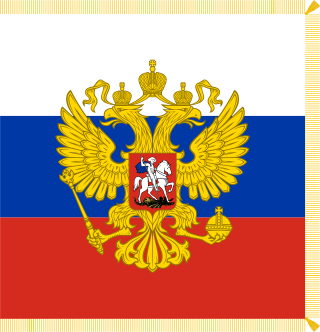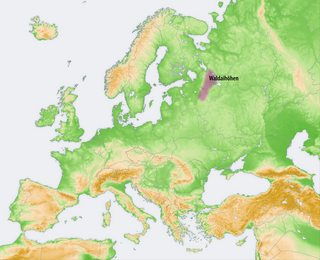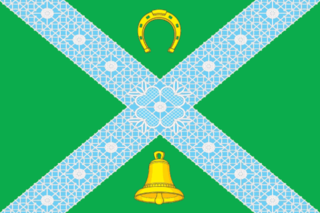
The President of the Russian Federation is the executive head of state of Russia. The president is the chair of the Federal State Council and the supreme commander-in-chief of the Russian Armed Forces. It is the highest office in Russia.

Novgorod Oblast is a federal subject of Russia. Its administrative center is the city of Veliky Novgorod. Some of the oldest Russian cities, including Veliky Novgorod and Staraya Russa, are located in the oblast. The historic monuments of Veliky Novgorod and surroundings have been declared a UNESCO World Heritage Site. Population: 583,387.

The Valdai Hills, sometimes shortened to Valdai, are an upland region in the north-west of central European Russia running north–south, about midway between Saint Petersburg and Moscow, spanning Leningrad, Novgorod, Tver, Pskov, and Smolensk Oblasts.

The Pola is a river in Andreapolsky and Penovsky Districts of Tver Oblast and Maryovsky, Demyansky, and Parfinsky Districts of Novgorod Oblast in Russia. It is a tributary of Lake Ilmen. It is 267 kilometres (166 mi) long, and the area of its basin 74,200 square kilometres (28,600 sq mi). The principal tributaries of the Pola are the Maryovka, Kamenka, Yavon, and Polomet rivers, all from the right.

Valday is a town and the administrative center of Valdaysky District in Novgorod Oblast, Russia, located on the southwestern shore of Lake Valdayskoye, the biggest one in the set of lakes in the highest region of the Valdai Hills, on the M10 Highway connecting Moscow and St. Petersburg, 386 kilometers (240 mi) from Moscow and 140 kilometers (87 mi) from Veliky Novgorod, the administrative center of the oblast. Population: 16,098 (2010 Census); 18,703 (2002 Census); 19,173 (1989 Soviet census).
The Berezayka is a river in Valdaysky District of Novgorod Oblast and Bologovsky District of Tver Oblast of Russia. It is left tributary of the Msta and belongs to the drainage basin of the Neva and the Baltic Sea. It is 150 kilometres (93 mi) long, and the area of its drainage basin is 3,230 square kilometres (1,250 sq mi). The principal tributary of the Berezayka is the Valdayka (left).

The Valdayka is a river in Valdaysky District of Novgorod Oblast and in Bologovsky District of Tver Oblast in Russia. It is a tributary of Lake Piros and belongs to the basin of the river Msta. It is 50 kilometres (31 mi) long, and the area of its basin 783 square kilometres (302 sq mi).

Novo-Ogaryovo, also transliterated as Novo-Ogarevo, is an estate in the Odintsovsky District of Moscow Oblast, located by the Rublyovo-Uspenskoye Highway west of the city of Moscow. It operates as the suburban residence of the President of Russia, officially recognized as such in 2000, although, throughout President Vladimir Putin's second tenure, he has spent progressively more time at Novo-Ogaryovo, so much so that it has been unofficially termed the de facto residence of the head of state.
Ozero is a dacha cooperative in northwest Russia associated with Vladimir Putin's inner circle.
Yury Valentinovich Kovalchuk is a Russian billionaire businessman and financier who is "reputed to be Vladimir Putin's personal banker". The Panama Papers leak revealed that Kovalchuk had transferred at least $1 billion to an offshore entity.

Valday Iversky Monastery is a Russian Orthodox monastery founded by Patriarch Nikon in 1653. The monastery is located on an island in Lake Valdayskoye in Valdaysky District of Novgorod Oblast, Russia, close to the town of Valday. In the 17th century, the Valday Iversky Monastery was one of the most influential monasteries in Russia and a significant cultural center.
The Kuntsevo Dacha was Joseph Stalin's personal residence between Moscow and Davydkovo, where he lived for the last two decades of his life and died on 5 March 1953. Stalin also spent much time inside the Kremlin, where he possessed living quarters next to his offices. The dacha is located in a forest not far from the modern-day Victory Park.

"Putin's Palace" is an Italianate palace complex located on the Black Sea coast near Gelendzhik, Krasnodar Krai, Russia.

Krestetsky District is an administrative and municipal district (raion), one of the twenty-one in Novgorod Oblast, Russia. It is located in the center of the oblast and borders with Malovishersky District in the north, Okulovsky District in the northeast, Valdaysky District in the southeast, Demyansky District in the south, Parfinsky District in the southwest, and with Novgorodsky District in the northwest. The area of the district is 2,790.63 square kilometers (1,077.47 sq mi). Its administrative center is the urban locality of Kresttsy. Population: 12,940 (2010 Census); 15,667 ; 16,957 (1989 Soviet census). The population of Kresttsy accounts for 67.4% of the district's total population.

Valdaysky District is an administrative and municipal district (raion), one of the twenty-one in Novgorod Oblast, Russia. It is located in the southeast of the oblast and borders with Okulovsky District in the north, Bologovsky District of Tver Oblast in the east, the territory of the closed administrative-territorial formation of Ozyorny of Tver Oblast in the southeast, Firovsky District of Tver Oblast in the south, Demyansky District in the southwest, and with Krestetsky District in the northwest. The area of the district is 2,701.63 square kilometers (1,043.11 sq mi). Its administrative center is the town of Valday. Population: 26,476 (2010 Census); 29,943 ; 32,373 (1989 Soviet census). The population of Valday accounts for 60.8% of the district's total population.

Bologovsky District is an administrative and municipal district (raion), one of the thirty-six in Tver Oblast, Russia. It is located in the north of the oblast and borders with Borovichsky District of Novgorod Oblast in the north, Udomelsky District in the east, Vyshnevolotsky District in the southeast, Firovsky District and the urban-type settlement of Ozyorny in the south, Valdaysky District of Novgorod Oblast in the west, and with Okulovsky District, also of Novgorod Oblast, to the northwest. The area of the district is 2,463.7 square kilometers (951.2 sq mi). Its administrative center is the town of Bologoye. Population: 38,557 ; 18,757 (2002 Census); 32,790 (1989 Soviet census). The population of Bologoye accounts for 60.9% of the district's total population.

Valdaysky National Park is a national park in the north of Russia, located in Valdaysky, Okulovsky, and Demyansky Districts of Novgorod Oblast. It was established May 17, 1990. Since 2004, the national park has the status of a UNESCO Biosphere Reserve. Valdaysky National Park, which includes the town of Valday, Lake Valdayskoye, and the northern part of Lake Seliger, is one of the most popular tourist destinations in Central Russia and has well-developed tourist infrastructure.
Valday is the name of several inhabited localities in Russia.
Dolgiye Borody also known as other names "Valdai" and "Uzhin" is a residence of the president of the Russian Federation and is located in the Novgorod Oblast, 20 kilometers from the city of Valdai, near the village of Dolgiye Borody.
Putin's dacha may refer to:















